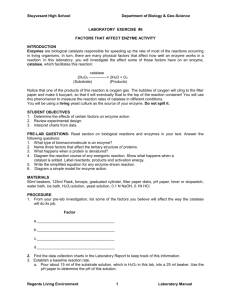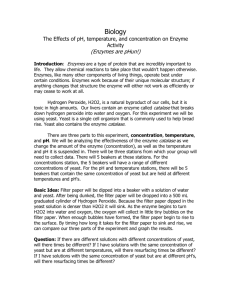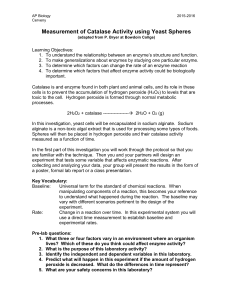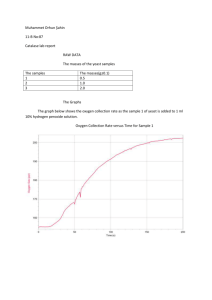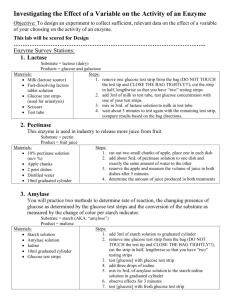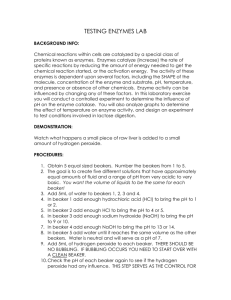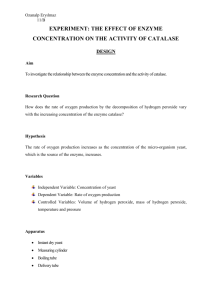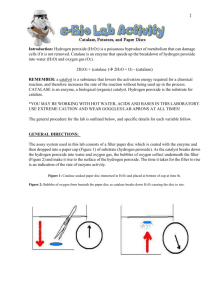Enzyme Activity
advertisement
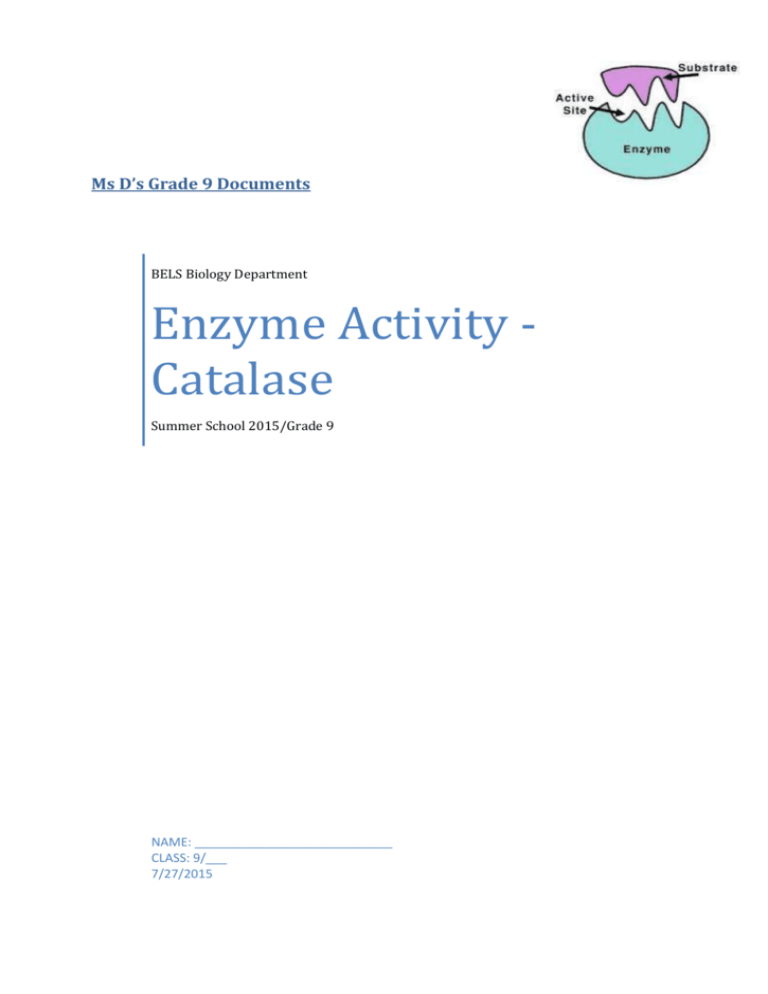
Ms D’s Grade 9 Documents BELS Biology Department Enzyme Activity Catalase Summer School 2015/Grade 9 NAME: ____________________________ CLASS: 9/___ 7/27/2015 Objectives: This experiment allows you to collect data on enzyme activity using a procedure easy and to follow. The data can be plotted and analyzed, and conclusions about the effects of enzyme concentration on product formation can be drawn. Introduction: Already given in the previous handout about Catalase Lab. Please refer to that handout and put here a brief background information. Research Question: Hypothesis: Variables: Independent Variable: Dependent variable: Controlled Variables: Materials: per team of students: • 1 x 250 ml graduated cylinder • graph paper • glass stirring rod • funnel Filter paper • Catalase solution obtained from yeast suspension (500 ml) 500 ml water 50 g yeast • marking pens 1 x 250 ml Beaker • 5 x 250 ml beakers or reaction bottle 1 • stop watch or clear view of a clock with a second hand • hydrogen peroxide (25 ml) [5 ml per reaction] Procedure: 1. Making the yeast suspension: • Follow the steps to prepare the yeast suspension as follows: • Weigh 25 mg/g yeast and measure 125 ml water • Pour 125 ml %1 concentrated yeast suspension through 1 layer of filtered paper placed in funnel. Collect as much fluid as possible. This fluid contains the enzyme catalase, among many other things that were stored inside the cells of the potato. • Add enough water to bring the final volume to 125 ml per yeast suspension. Swirl the flask to mix the solution. This will be arbitrarily designated as “100%” catalase extract. (Each team should have a 250 ml beaker containing 250 ml of 100% catalase.) 2. Together with your partners, prepare your enzyme concentrations in the beakers. • Label the beakers with tape and pen: 20%, 40%, 60%, 80%, and 100%. • Make the appropriate dilutions. For example, if you are doing test #1(20%), measure 8.0 ml of the potato extract using the graduated cylinder and pour into the beaker. • Rinse the graduated cylinder, then add 32.0 ml of H2O and stir well with the stirring rod. • Make the rest of the enzyme solutions using the chart below as a guide. Test Extract Concentration #1 20% #2 40% #3 60% #4 80% #5 100% Volume of Enzyme Volume of Water 8 ml 16 ml 24 ml 32 ml 40 ml 32 ml 24 ml 16 ml 8 ml 0 ml • Obtain the flask of hydrogen peroxide if it is not at your table. This is the substrate for this part of the lab. 3. Now you are ready to begin measuring the effects of enzyme concentration on enzyme activity. • Pour 5 ml of the 10% H2O2 solution into a clean beaker, labeled “reaction beaker.” 4. The reaction is now ready to be started and timed. 2 • Watch the reaction beaker. You should see tiny bubbles of oxygen being released as the hydrogen peroxide is broken into water and oxygen by the catalase. • Record the time in seconds for each trial on the chart. Be precise in your timing and recording. • Remove the disk and discard it. 5. Obtain another beaker and repeat relevant steps exactly as done above. 6. Repeat the experiment a third time exactly as above: now you have 5 trials measurements of the rate of oxygen production in 10% H2O2 at each particular enzyme concentration. Average these 5 values and record in the chart. Repeat this procedure for all the concentrations of enzyme. Clean up!!! 1. Use the lavatory next to aquarium 2. Clean your materials and put those in place after you dry them before you leave the lab 3. Draw the appropriate graph to present processed data 4. Write your report and submit it in next Biology period to Ms D. Data Collection: Raw Data: (the data you are collecting without any calculations or conversions) Draw a table following the rules you have learned in class, to show the data you have collected. Processed Data: What calculations will you make? Draw a table following the rules you have learned in class, to show the processed data. Presentation of Processed Data: What type of graph would be suitable? Remember the rules for the particular graph. Conclusion and Evaluation: What was your purpose for conducting this experiment? Did your findings support your hypothesis? 3 What is the trend of the data? Is there any anomaly points that you need to discuss? How would you improve this experiment if you are asked to re-conduct the experiment? References: 4
